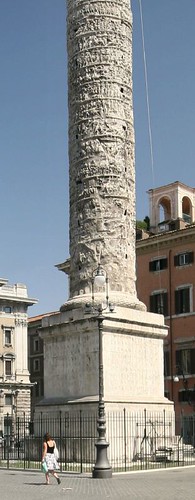
This photo of the Column of Marcus Aurelius is part of one of the panoramic images found on the PanoramicEarth.com Tour of Rome. There are over 100 images taken from around
The Column of Marcus Aurelius (also known as Colonna Antonia) is another ancient monument in
Marcus Aurelius of the Antonia family became joint Roman emperor in 161 with Versus after the death of Antonius Pius. He is one of the ‘5 Good Emperors’ who ensured their succession by nomination thus avoiding the turmoil and revolt that normally accompanied the death of an Emperor. Unfortunately for Marcus, his son Commodus proved a poor and egotistical successor whose rule marked the end of Pax Romana as the empire entered decline. Marcus Aurelius was also an important stoic philosopher.
During the rule of Marcus Aurelius Rome was facing war with both the Germans and Persians, and it is this that the column depicts. It is formed of 27 blocks of Luni marble and, together with the pedestal, stands some 42m high. It’s design is similar to Trajan’s column located next to Trajan’s Forum. Thus the battle scenes ascend in spiral bands around the column, though they are far more realistic and bloody than those of Trajan.
There are 20 spirals, interrupted half way by a Victory. The lower section deals with the wars against the Germans (169-73) while the Samaritan conflict occupies the upper sections. On the third spiral, on the east side, the base relief depicts the Roman army being saved by a rain storm which, in the 4C, was attributed as a miraculous answer to prayer by the Christians in their ranks.
The centre of the column is hollow and a spiral staircase ascends to the top via 200 steps. This is now rarely open to the public though in the Middle Ages the column was the property of the Convent of St. Silvester and monks would ask for alms from the pilgrims wishing to ascend.
Originally the column was topped with a statue of Marcus Aurelius and his wife Faustina, but this was replaced by a statue of
In the Middle Ages, the piazza was at the intersection of the two most important pilgrim routes in
A full panoramic image showing the Piazza Colonna is found on the Rome tour by PanoramicEarth.com. An enlargement of this photo can be found on Flickr.
For more articles on
No comments:
Post a Comment